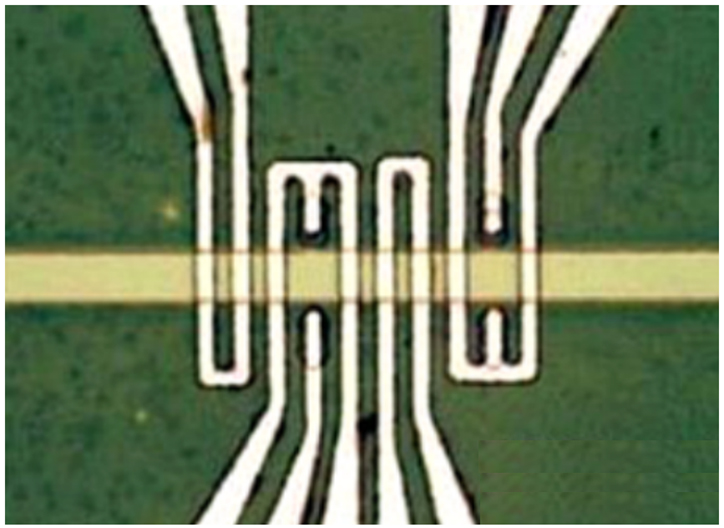‘Multiferroics’ advances promise increased power efficiency for future computer processors
March 7, 2014

A picture of spin wave devices, showing magneto-electric cells used for voltage-controlled spin wave generation in the spin wave bus material (yellow stripe). The yellow stripe is about four micrometers in diameter. (Credit: UCLA)
A team led by researchers from the UCLA Henry Samueli School of Engineering and Applied Science has made major improvements in computer processing using an emerging class of magnetic materials called “multiferroics,” and these advances could make future devices far more energy-efficient than current technologies.
With today’s microprocessors, electric current passes through transistors (electronic switches). Because current involves the movement of electrons, this process produces heat — which makes devices warm to the touch.
These switches can also “leak” electrons, making it difficult to completely turn them off. And as chips continue to get smaller, with more circuits packed into smaller spaces, the amount of wasted heat grows, limiting further miniaturization.
The ‘spin wave bus’
The UCLA Engineering team used multiferroic magnetic materials to reduce the amount of power consumed by “logic devices,” a type of circuit on a computer chip dedicated to performing functions such as calculations. A multiferroic can be switched on or off by applying alternating voltage. Instead of using current, it then carries power through the material in a cascading wave via the spins of electrons, a process referred to as a “spin wave bus.”
The researchers showed that using this multiferroic material to generate spin waves could reduce wasted heat and therefore increase power efficiency for processing by up to 1,000 times. Their research is published in the journal Applied Physics Letters.
A spin wave can be thought of as similar to an ocean wave, which keeps water molecules in essentially the same place while the energy is carried through the water, as opposed to an electric current, which can be envisioned as water flowing through a pipe, said principal investigator Kang L. Wang, UCLA’s Raytheon Professor of Electrical Engineering and director of the Western Institute of Nanoelectronics (WIN).
“Spin waves open an opportunity to realize fundamentally new ways of computing while solving some of the key challenges faced by scaling of conventional semiconductor technology, potentially creating a new paradigm of spin-based electronics,” Wang said.
“Electrical control of magnetism without involving charge currents is a fast-growing area of interest in magnetics research,” said co-author Pedram Khalili, a UCLA assistant adjunct professor of electrical engineering. “It can have major implications for future information processing and data-storage devices, and our recent results are exciting in that context.”
The researchers previously applied this technology in a similar way to computer memory.
UC Riverside’s Bourns College of Engineering and the National Science Foundation-funded Center for Translational Applications of Nanoscale Multiferroic Systems (TANMS), which focuses on multiferroic device applications, were also involved in the research.
The research was funded by the Defense Advanced Research Projects Agency’s Non-Volatile Logic program and by the Nanoelectronics Research Initiative through the WIN.
Abstract of Applied Physics Letters paper
In this work, we report on the demonstration of voltage-driven spin wave excitation, where spin waves are generated by multiferroic magnetoelectric (ME) cell transducers driven by an alternating voltage, rather than an electric current. A multiferroic element consisting of a magnetostrictive Ni film and a piezoelectric [Pb(Mg1/3Nb2/3)O3](1−x)–[PbTiO3]x substrate was used for this purpose. By applying an AC voltage to the piezoelectric, an oscillating electric field is created within the piezoelectric material, which results in an alternating strain-induced magnetic anisotropy in the magnetostrictive Ni layer. The resulting anisotropy-driven magnetization oscillations propagate in the form of spin waves along a 5 μm wide Ni/NiFe waveguide. Control experiments confirm the strain-mediated origin of the spin wave excitation. The voltage-driven spin wave excitation, demonstrated in this work, can potentially be used for low-dissipation spin wave-based logic and memory elements.